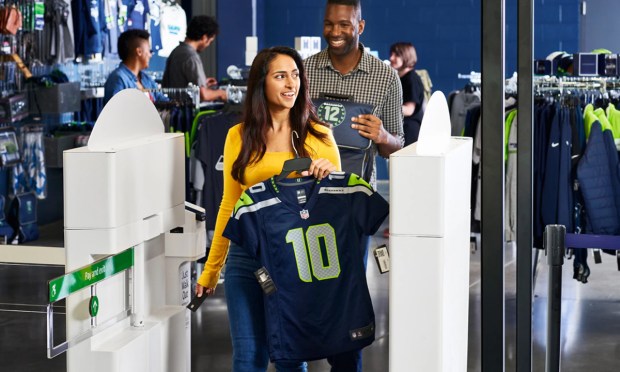Amazon Licenses Just Walk Out Tech in Battle for Grocery Stores’ Loyalty

Amazon is pushing sales of its Just Walk Out technology even as it pulls back on the checkout system in its own grocery stores, a move that comes as tech giants compete to own the Click-and-Mortar™ grocery experience.
The company recently shifted away from the technology to smart carts in its grocery stores, but according to a blog post Wednesday (April 17) from Dilip Kumar, vice president at AWS Applications, the company maintains that the technology works for smaller stores and that it will be a viable system for full-format supermarkets down the line.
“While we’re growing the number of smaller format Just Walk Out stores, the team continues to invent the next generation of this technology to improve the checkout experience for large-format stores,” Kumar said. “We’re building edge compute and the associated algorithms to improve latency and accuracy for faster and more reliable receipts, a new set of algorithms for action recognition, and new sensors so retailers can offer customers even greater selection.”
He contended that reports that the technology relied on around 1,000 employees in India who monitored the items customers collected were inaccurate, adding that employees handle “labeling and annotation” of the data rather than them viewing “video of shoppers to generate receipts.”
This post comes alongside a report from Bloomberg Wednesday noting that the company is expanding its efforts to license out its Just Walk Out technology, planning to roll it out to 120 non-Amazon-owned stores before the year’s end.
Indeed, Amazon is competing with Instacart to be the eCommerce engine for the brick-and-mortar grocery store. Instacart has been rolling out a range of in-store technologies to grocers to digitize the experience, including smart carts and own-device scan-and-pay among others.
Grocers, for their part, are looking to third-party tech to manage their digital presences so that they can focus on their core business — product and price. The flip side of this utilization of third-party technology providers is that it makes grocers highly dependent on these companies.
Still, consumers demand omnichannel experiences. The PYMNTS Intelligence study “2024 Global Digital Shopping Index: The Rise of the Click-and-Mortar™ Shopper and What It Means for Merchants,” commissioned by Visa Acceptance Solutions and drawing from a survey of nearly 14,000 consumers across seven countries, finds that 39% of consumers are now Click-and-Mortar shoppers™, engaging across digital and physical channels.
Additionally, Amazon’s efforts to improve checkout in its physical stores comes as the company leverages brick-and-mortar in an effort to grow its share of grocery, a category in which it trails far behind rival Walmart.
PYMNTS Intelligence’s “Whole Paycheck Report: New Consumer Spend Data Finds Amazon Way Ahead of Walmart” estimates each of the two retailers’ market shares in various categories based on their earnings reports from Q1 2019 through Q4 2023, in conjunction with national data from the U.S. Census Bureau and Bureau of Economic Analysis. Findings showed that, as of Q4 2023, Amazon held only a 3% of consumers’ food and beverage spending, while Walmart captured 19%.

